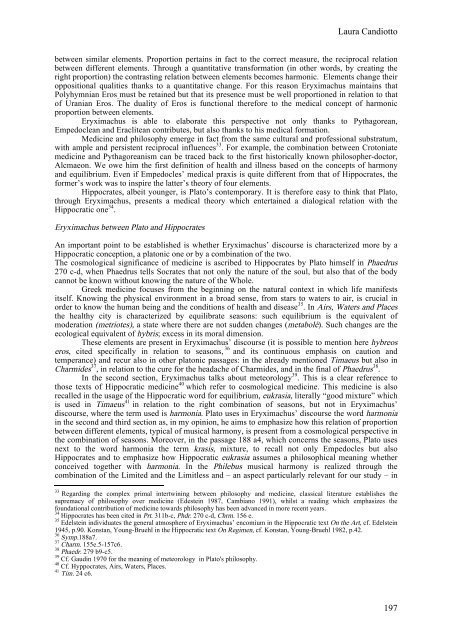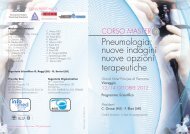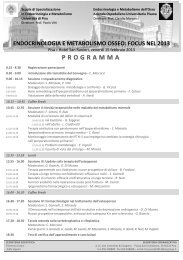Create successful ePaper yourself
Turn your PDF publications into a flip-book with our unique Google optimized e-Paper software.
Laura Candiotto<br />
between similar elements. Proportion pertains in fact to the correct measure, the reciprocal relation<br />
between different elements. Through a quantitative transformation (in other words, by creating the<br />
right proportion) the contrasting relation between elements becomes harmonic. Elements change their<br />
oppositional qualities thanks to a quantitative change. For this reason Eryximachus maintains that<br />
Polyhymnian Eros must be retained but that its presence must be well proportioned in relation to that<br />
of Uranian Eros. The duality of Eros is functional therefore to the medical concept of harmonic<br />
proportion between elements.<br />
Eryximachus is able to elaborate this perspective not only thanks to Pythagorean,<br />
Empedoclean and Eraclitean contributes, but also thanks to his medical formation.<br />
Medicine and philosophy emerge in fact from the same cultural and professional substratum,<br />
with ample and persistent reciprocal influences 33 . For example, the combination between Crotoniate<br />
medicine and Pythagoreanism can be traced back to the first historically known philosopher-doctor,<br />
Alcmaeon. We owe him the first definition of health and illness based on the concepts of harmony<br />
and equilibrium. Even if Empedocles’ medical praxis is quite different from that of Hippocrates, the<br />
former’s work was to inspire the latter’s theory of four elements.<br />
Hippocrates, albeit younger, is Plato’s contemporary. It is therefore easy to think that Plato,<br />
through Eryximachus, presents a medical theory which entertained a dialogical relation with the<br />
Hippocratic one 34 .<br />
Eryximachus between Plato and Hippocrates<br />
An important point to be established is whether Eryximachus’ discourse is characterized more by a<br />
Hippocratic conception, a platonic one or by a combination of the two.<br />
The cosmological significance of medicine is ascribed to Hippocrates by Plato himself in Phaedrus<br />
270 c-d, when Phaedrus tells Socrates that not only the nature of the soul, but also that of the body<br />
cannot be known without knowing the nature of the Whole.<br />
Greek medicine focuses from the beginning on the natural context in which life manifests<br />
itself. Knowing the physical environment in a broad sense, from stars to waters to air, is crucial in<br />
order to know the human being and the conditions of health and disease 35 . In Airs, Waters and Places<br />
the healthy city is characterized by equilibrate seasons: such equilibrium is the equivalent of<br />
moderation (metriotes), a state where there are not sudden changes (metabolè). Such changes are the<br />
ecological equivalent of hybris; excess in its moral dimension.<br />
These elements are present in Eryximachus’ discourse (it is possible to mention here hybreos<br />
eros, cited specifically in relation to seasons, 36 and its continuous emphasis on caution and<br />
temperance) and recur also in other platonic passages: in the already mentioned Timaeus but also in<br />
Charmides 37 , in relation to the cure for the headache of Charmides, and in the final of Phaedrus 38 .<br />
In the second section, Eryximachus talks about meteorology 39 . This is a clear reference to<br />
those texts of Hippocratic medicine 40 which refer to cosmological medicine. This medicine is also<br />
recalled in the usage of the Hippocratic word for equilibrium, eukrasia, literally “good mixture” which<br />
is used in Timaeus 41 in relation to the right combination of seasons, but not in Eryximachus’<br />
discourse, where the term used is harmonia. Plato uses in Eryximachus’ discourse the word harmonia<br />
in the second and third section as, in my opinion, he aims to emphasize how this relation of proportion<br />
between different elements, typical of musical harmony, is present from a cosmological perspective in<br />
the combination of seasons. Moreover, in the passage 188 a4, which concerns the seasons, Plato uses<br />
next to the word harmonia the term krasis, mixture, to recall not only Empedocles but also<br />
Hippocrates and to emphasize how Hippocratic eukrasia assumes a philosophical meaning whether<br />
conceived together with harmonia. In the Philebus musical harmony is realized through the<br />
combination of the Limited and the Limitless and – an aspect particularly relevant for our study – in<br />
33 Regarding the complex primal intertwining between philosophy and medicine, classical literature establishes the<br />
supremacy of philosophy over medicine (Edestein 1987, Cambiano 1991), whilst a reading which emphasizes the<br />
foundational contribution of medicine towards philosophy has been advanced in more recent years.<br />
34 Hippocrates has been cited in Prt. 311b-c, Phdr. 270 c-d, Chrm. 156 e.<br />
35 Edelstein individuates the general atmosphere of Eryximachus’ encomium in the Hippocratic text On the Art, cf. Edelstein<br />
1945, p.90. Konstan, Young-Bruehl in the Hippocratic text On Regimen, cf. Konstan, Young-Bruehl 1982, p.42.<br />
36 Symp.188a7.<br />
37 Charm. 155e.5-157c6.<br />
38 Phaedr. 279 b9-c5.<br />
39 Cf. Gaudin 1970 for the meaning of meteorology in Plato's philosophy.<br />
40 Cf. Hyppocrates, Airs, Waters, Places.<br />
41 Tim. 24 c6.<br />
197




